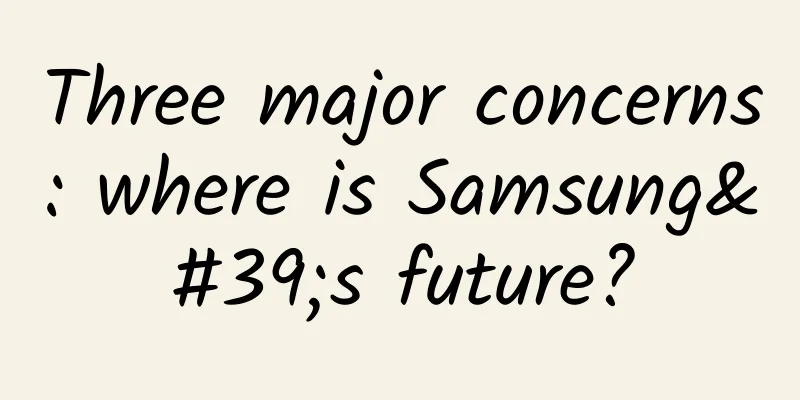Three major concerns: where is Samsung's future?

|
Samsung Electronics announced its second quarter results yesterday, and data showed that Samsung Electronics' second quarter revenue was about 41.7 billion US dollars, a year-on-year decrease of 7%; net profit fell 8% year-on-year to about 5 billion US dollars. At the same time, Samsung's second quarter mobile phone division's profit did not improve, and its mobile business profit fell to 2.76 trillion won, which was the highest in the past four quarters, but still lower than 4.42 trillion won in the same period last year. It is worth noting that this is the fifth consecutive quarter that Samsung has had a net profit drop. At the same time, according to data from market research firm IDC, although Samsung is still the world's largest smartphone manufacturer, its market share has dropped from 25% to 22%. In addition, Samsung did not announce its smartphone sales in the second quarter, but according to data released by market research firm Gartner, Samsung sold 8,110 smartphones in the first quarter, a year-on-year decrease of 4.4 million units, and this figure will decline in the second quarter. As the former mobile phone overlord, Samsung has gradually withdrawn from the competition with Apple, and its brilliant data has become a thing of the past. Why has Samsung, which has an advantage in patents, screens and processors, fallen into the current situation? ***, the price is too high. As we all know, Samsung mobile phones have always claimed to be high-end, and the price of new phones has never been lower than 5,000. Because the size of previous iPhone phones was small and could not meet the requirements of some people, Samsung had a very big advantage in the large-screen mobile phone market. However, with the launch of iPhone6/plus, Samsung mobile phones suffered a great blow. At the same time, coupled with the impact of domestic mobile phone brands, Samsung's sales continued to decline. Later, Samsung realized the importance of mid-range layout and launched the Galaxy Alpha series of mobile phones, but it was still difficult to change the concept of low configuration and high price, and it was inevitable to suffer a Waterloo. Subsequently, Samsung launched the Galaxy A series of mobile phones, once again trying to explore the mid-range market, using an all-metal body and priced between 1,800 and 3,000 yuan. However, facing the impact of high cost-effective domestic mobile phones, Samsung's road to mid-range mobile phones is inevitably very bumpy. Second, the lack of innovation. Samsung has a very big "advantage" in manufacturing technology, and can polish plastic materials to have a metallic texture. This was a kind of irony before Samsung launched the S6. People now pursue personalization and customization more, and configuration can hardly be the main attraction. The plastic body that has not changed for thousands of years, coupled with the design style, has long made consumers aesthetically fatigued. The low sales of Samsung Galaxy S5 can well illustrate this point. After that, Samsung launched the all-metal polished Galaxy S6/edge, which received wide acclaim in the market. However, Samsung also dug a hole for itself. With insufficient production capacity, it watched such a good opportunity for a turnaround slip away. Samsung, what are you doing? Third, the system optimization is poor and there are many pre-installed software. In addition to the unchanging plastic body design, Samsung's system has always been a point of complaint. For the Android system, the slower it gets the more it is used is its biggest disadvantage. Domestic mobile phone manufacturers basically make some optimizations on the native Android system, and both the interface and speed have been improved to a certain extent. On the other hand, Samsung has never thought about changing. Basically, in about a year, the phone has become more laggy, and it is useless even if the phone is flashed. At the same time, Samsung phones will be pre-installed with more software when they leave the factory, and they cannot be uninstalled, making the user experience worse. The same system, too many pre-installed software, poor system optimization, and the configuration is not much higher than that of domestic mobile phones. The most important thing is that the price is more than doubled. How many people will buy it? Written in ***: Although Samsung has a big advantage in chips, batteries and screens, the current advantages do not represent the future market, especially for the current domestic market, high cost performance is what most people pursue. Although there are also some layouts in the mid-range, if Samsung wants to really reverse the decline, it must put down its airs. If it still maintains its previous sense of superiority, it is doomed to be ignored by the market. In two years, Samsung grew into a giant in the mobile phone market, and it only took a few months to decline. Let us wait and see whether Samsung can return to its heyday in the future. |
<<: Making software for Mac? What is Hammer trying to do?
>>: Startup teams, don’t wait until you’re out of money to realize these truths
Recommend
Hydrogen energy, it’s not easy to say I love you
Excerpted from: Inside and Outside the Classroom ...
3 common scenarios for community operations!
First of all, we must make it clear that a commun...
A new opening in 2022, mobile phone batch brick-moving gameplay, one mobile phone daily 2000+
A new opening in 2022, mobile phone batch brick-m...
How did the once rampant trachoma disappear? The whole world should thank this Chinese man
Because the human body's constant body temper...
Face to face | Me and my fathers who made two bombs and one satellite
In the history museum of the Beijing No. 9 Resear...
Wu Dayong丨From mask making to cancer screening, nanofibers are so powerful
A distance as short as one millimeter, In fact, i...
“How Much Do You Know About Food Nutrition” Series | Can an “Anti-Inflammatory Diet” Really Boost Immunity?
Recently, "anti-inflammatory diet" and ...
Product operation: Let users share the deep logic of fission!
A good product will make users want to share, spo...
Can Valve's pre-sale of handheld consoles be a catalyst for Steam's development?
Players who are familiar with PC games are also f...
Five friends had excessive blood lead levels at the same time! After testing all the pots and pans at home, the reason turned out to be a folk remedy
Some time ago, a fan came to us and said that he ...
Apple's stock price plummeted 6% and has embarked on a bear market
On Friday, Apple's stock price plummeted agai...
Astronomers directly observed the birth of a "planet" for the first time, and it's only 520 light-years away from us!
【Mobile software: Bo Ke Yuan】 Observations with t...
Electromagnetic waves cannot propagate effectively in water, so how do torpedoes find their targets?
Whether the bullet can hit the target accurately ...
The emergency department is not a "night clinic"! When a sudden illness occurs, you should do this
Author: Ying Jusu, Chief Nurse, Peking University...
Be the cosmic dream maker for children! A group of Hangzhou programmers built a smart observatory in the village
Programmers and the vast starry sky, two complete...









